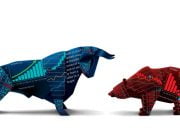The market was expecting nothing from the Fed, and it got nothing from the Fed.
That’s more or less exactly what the market wanted.
That didn’t stop stocks, which had been rallying nicely, from taking a morning breather ahead of Chair Jerome Powell’s announcement. I guess investors wanted to hear it right from the horse’s mouth, to make sure that the “nothing” they were counting on was actually official and actually nothing.
The Fed-investor love fest, which has been ongoing throughout the 10-year bull market, is obscuring an alarming truth…
The central bank is caught between a rock and a hard place… and a hard place… and a rock… and another rock – all very pointy and sharp.
That’s no exaggeration, and I’ll tell you what I mean in a second.
Then I’m going to name the very best assets to own before the central bank falls flat once and for all…
The Federal Reserve Can’t Keep Up the Act Forever
You can almost feel sorry for Chair Jerome Powell and the rest of the Federal Reserve crowd… almost.
Most of us wake up every morning with a list of things to do in order, one after another.
The Fed, on the other hand, has quite a few plates spinning, so to speak.
Officially, the Fed has a “dual mandate” – unique among the world’s central banks. It’s charged with keeping inflation and prices in check through monetary policy, but it’s also responsible for ensuring maximum employment.
In reality, that dual mandate is looking more and more like fixing a train wreck. An impossible task.
Related: Man Who Predicted Trump Has Bad News for 2020
The central bank has to keep a 10-year-plus bull market afloat that it’s “officially” supposed to have nothing to do with, but which it fueled with $4.5 trillion worth of quantitative easing from 2008 to 2014.
The Fed must contend with a weakening economy here and increasingly grim economic data abroad; there is virtually no “dry powder,” no ammunition left with which to fight recessionary pressures in the United States.
With the Fed funds rate at 2.5%, Powell & Co. have perhaps 250 basis points of breathing room should the slowdown accelerate. There’s no strategic depth, little room to fight, and little to fight with. In any event, we’d be faced with a “ZIRP 2” situation at a time when inequality is spiraling, the middle class has been squeezed almost to death, and savings have been decimated.
(As it happens, the Trump tax cuts would likely prove an excellent, effective tool for fighting recession. Unfortunately, they were implemented near the peak of a huge economic expansion amid nearly full employment. The right idea at the exact wrong time.)
And speaking of Trump, the president is leaning hard on Chair Powell and the Fed. He wants a far easier monetary policy than would be prudent right now, with ominous tweets about “matching” the European Central Bank’s rates, or “lower” interest rates in general. It’s unclear how inclined or how well equipped the Fed is to resist that pressure, which by now is enormous.
After all, the amount of global debt with negative interest rates now sits at $12 trillion after 10-year yields just turned negative in France and Austria for the first time in history.
Of course, the Fed is supposed to be politically neutral. An independent monetary policy is the hallmark of thriving democracies the world over. In a place like Venezuela, say, there is no independent central bank. And there are multiple exchange rates thanks to two monetary policies; an extremely favorable one for the ruling elite… and the slow starvation of the Law of the Jungle for the “little people.”
And that’s what the Fed has to contend with right now. They may have said the “right” thing yesterday, but it’s only a matter of time before it all spins out of their control.
Before that happens, make sure you have these amazing protective-profit stocks in your holdings; you don’t want to be the one that’s out of ammo when this happens.
This Gets You a Fed-Proof, Crash-Resistant Portfolio
These are alternative investments, but not in the “popular” sense of gold, crypto, luxury watches, stamps, and what have you. They’re alternative in the sense that they’re nontraditional and way too many people ignore them.
That means more upside for us – and more downside protection, too.
Editor’s Pick: Video: Stock Flipping Formula makes forklift driver nearly $25M
The conventional wisdom will tell you to buy a mix of blue chips and bonds, and to “diversify” with index and mutual funds, and even (terrible) annuities.
And certainly there are plenty of blue chips worth owning. A little bond exposure can be a good thing, too.
But these are what you really want to own at a time when things are looking mighty uncertain.
Profitable Protector No. 1: Closed-End Funds
We’ve discussed these recently, but here’s a quick refresher. Closed-end funds (CEFs) are effectively mutual funds that are no longer tied to the net asset value (NAV) of their underlying assets.
So, these funds trade on the public markets, on the bullish and bearish whims of the buyers and sellers. In many cases, these assets trade at a discount to NAV while paying a strong dividend.
Since CEFs are subject to some of the same forces as stocks, investors can push the value higher and closer to the NAV while locking in solid income. This means you get the benefit of higher share price appreciation upside and the associated dividend.
And you can do so on the cheap on great companies.
How about this: One single Class A share of Warren Buffett’s Berkshire Hathaway Inc. (NYSE: BRK.A) trades at more than $310,000. And 100 shares of the Class B stock would cost $20,700.
Those are traditionally considered the only two ways to invest alongside Warren Buffett’s portfolio – and neither of those shares pays a dividend.
But the Boulder Growth & Income Fund (NYSE: BIF) trades for just $11 per share, has a dividend of 3.7%, and owns many of the stocks that Buffett owns – including Berkshire A shares, Berkshire B shares, JPMorgan Chase & Co. (NYSE: JPM), Cisco Systems Inc. (NASDAQ: CSCO), and Walmart Inc. (NYSE: WMT).
Oh, and it is currently trading at a discount of 16% to its net asset value.
Profitable Protector No. 2: Community Banks
Banking is about value and assets. The only way that banks can grow their deposits is to either buy another bank, or to somehow place themselves amid a surge in the population of businesses and consumers.
That latter factor might work for high-growth regions like Texas and Florida, but places losing their populations need to keep up. That means lots of community banks either need to get creative with their offerings… or sell to the highest bidder.
The thing is, many of these banks trade at a sharp discount to their tangible book value, meaning you could liquidate them tomorrow, and you’d make money on the stock.
Enter Customers’ Bancorp Inc. (NYSE: CUBI), a Wyomissing, Pa.–based community bank working to disrupt traditional banking with the help of T-Mobile US Inc. (NYSE: TMUS).
Here’s how it works: T-Mobile now has a no-fee, interest-earning, mobile-first checking account. Customers can earn up to 4% APY on their money – nearly four times the average APY – and avoid banking and overdraft fees.
It’s a first-of-its-kind deal – and a pretty good one, I’d say.
This vision is one thing that makes Customers’ an attractive takeover target due to the innovation and partnership with such a large mobile partner. It doesn’t matter what the Fed is going to do here because innovation trumps everything.
Finally, the stock is cheap – “cheap,” as in trading at a price to tangible book value of 0.82.
That makes it an attractive target for a larger bank looking to obtain deposits, a new customer base, and access to new technology. Community banking consolidation has been a major trend since the 1980s, and it will continue to happen well into the future.
Profitable Protector No. 3: Real Estate Investment Trusts
It might seem odd to recommend REITs as a defense against changes in the Fed rate, seeing as how they’re typically sensitive to those changes.
But it all depends on where you look…
Editor’s Pick: Retired Wall Street Legend: This “Hidden” Stock Is My No. 1 Pick For 2019
So, let’s get away from swanky New York and consumer retail space, and focus on the government.
As we know, the government isn’t going to stop paying its bills so long as it has a printing press.
Which gives us a REIT known as Easterly Government Properties Inc. (NYSE: DEA). This well-priced REIT pays a dividend of 5.55%.
What does it do?
It either buys or builds commercial properties that are leased to U.S. government agencies (Hence the DEA ticker).
So, when an agency needs additional space… it provides all of the necessary action and leases out those properties.
This “buy and build” model – which is based on government necessity – is why it has an enviable 100% occupancy rate.
That figure is pretty much unheard of in the real estate space, and it’s virtually baked in here.
Look, there’s no telling what might happen when the Fed loses control, though it’s almost guaranteed to be ugly and brutal.
Your very best defense is to put your hard-earned dollars where the fallout from this disaster-in-waiting can’t go.






